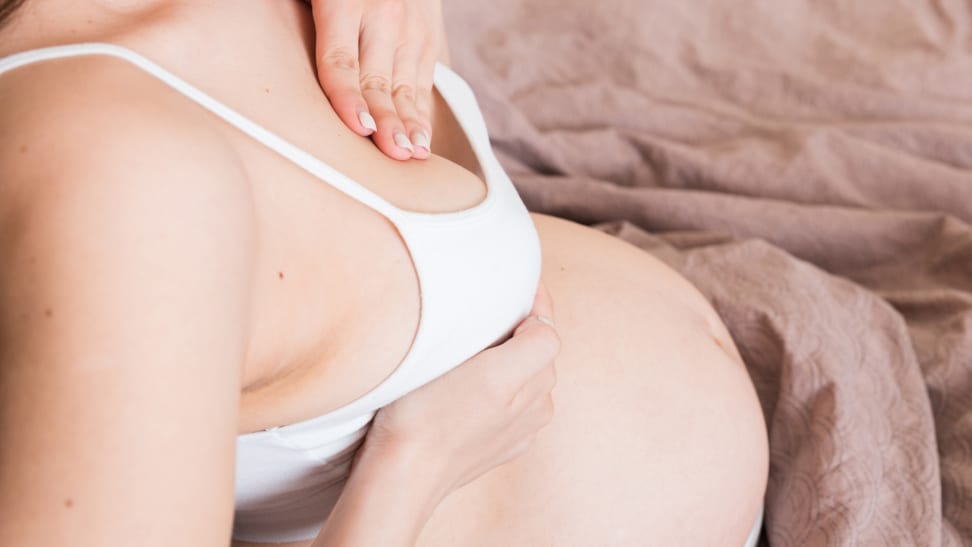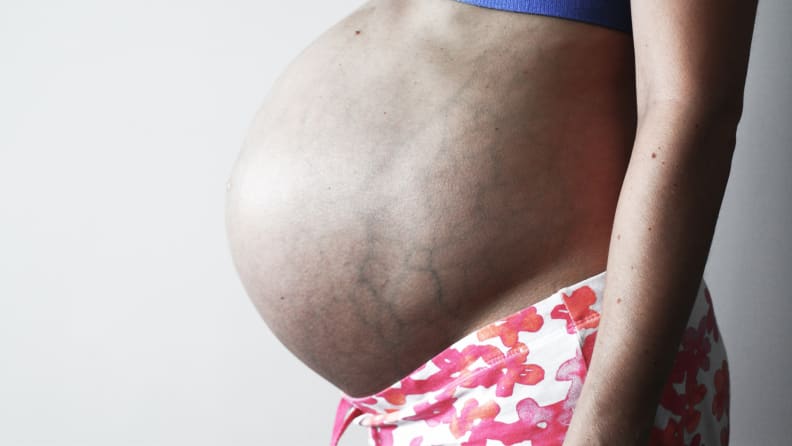Breast pain during pregnancy? Here are expert-recommended ways to help
Here’s how to treat the common breast changes during pregnancy.
 Credit:
Getty Images / Mykola Sosiukin
Credit:
Getty Images / Mykola Sosiukin
Recommendations are independently chosen by Reviewed's editors. Purchases made through the links below may earn us and our publishing partners a commission.
Though pregnancy is an exciting journey, growing a human over 40 weeks is an all-consuming job. A 2019 study even compared the endurance levels of extreme athletes (think: marathoners and Olympians) to the endurance requirements of expecting mothers. This likely comes as no surprise to anyone who has experienced pregnancy, since for most, symptoms start within a week or two of their missed period.
Though the protruding bump takes months to appear, one of the earliest signs of pregnancy begins in your breasts. Whether they feel fuller, more tender, or change in color and shape, the breast starts preparing for breastfeeding right from the get-go of conception. If you’re dealing with boob-specific aches and pains, go easy on yourself—you’re not the only one.
Luckily, OB-GYNs recommend a few lifestyle changes and products that will provide comfort and relief. Here are common problems, and solutions to managing breast change during pregnancy.
1. Your breasts feel heavy and full-feeling

The right maternity-specific bra can lessen the pain of heavy breasts.
Some women experience swollen breasts in the week leading up to their menstrual cycle. Often, relief comes on day one of their period, but the feeling can last for several months with pregnancy. Heavier, larger, and full-feeling, uncomfortable breast sensations are the first signs of being pregnant and of breast changes, according to Felice Gersh, founder and director of Integrative Medical Group in Irvine, California. Sadly it can feel quite severe, but once you reach your second trimester, it may become easier to tolerate or less intense.
“Recognize that your breast growth is essential, as before formula, every baby depended on breast milk to survive,” Gersh explains. “Breast growth and maturation—the development of mature ducts to deliver the manufactured human breast milk produced in the special glands of the breasts—ensure their capability to make adequate amounts of milk, a function essential to the survival of the baby.”
How to help: While, yes, your body is doing what it needs to do to prep for your baby’s arrival, it doesn’t make it easier to manage your, um, huge boobs. One of the best ways to find some support—no pun intended—is by finding great-fitting, underwire-free bras that can carry the weight, Gersh says. If you’ve gone up a cup size or two, she says it could be worthwhile to get professionally fitted, so you have a better understanding of your new fit.
Look into multi-purpose bras that provide support during pregnancy and postpartum, like Seraphine Baby Sensory Maternity & Nursing Bra, Storq Everyday Nursing & Maternity Bra or the Bodily Everything Bra. Also, if you tend to sleep bra-free, Gersh says it may be helpful to wear a cozy and soft sleep bra, like Kindred Bravely French Terry Racerback Nursing & Sleep Bra.
In short? The goal is to hoist ‘em up as much as you can.
2. Your breasts are sensitive and tender

Tender or sore breasts can be eased with the cold or warm compresses. Seems simple–works wonders.
In addition to being swollen, you may notice your breasts and your nipple area are more sensitive and tender, too. In fact, during the first trimester, it may be painful to brush up against anything or wear clothing. This is because the breast consists of glandular tissue, fat, and supporting tissue that gives the breast its shape, according to Angie Beltsos, an OB-GYN at the Vios Fertility Institute.
“The breast itself is highly glandular tissue that responds to estrogen and progesterone first during puberty and then during and after pregnancy,” she continues. “Tenderness can occur soon after conception, and under the influence of the early pregnancy hormones, the ductal system proliferates first.”
How to help: Beltsos says the intense sensitivity will likely wane in your second trimester as your pregnancy progresses. However, if you need relief now, she recommends cold and warm compresses like Lansinoh Therapearl 3-in-1 Breast Therapy Packs or Frida Mom Instant Heat Breast Warmers. These will come in handy again when you’re breastfeeding, too. Beltsos also suggests cutting down on caffeine (yep, even less than the tiny amount you can have while pregnant) if you’re feeling sore.
3. You have new stretch marks

Embrace your newfound stretch marks with pride.
During adolescence, it might have felt like your breasts grew seemingly overnight. The same phenomenon happens during pregnancy, and like those teenage years, it can result in stretch marks. Gersh says this is often a genetic tendency, so if it runs in your family, you may experience more of these "tiger stripes," as they are often nicknamed.
How to help: Gersh says since stretch marks on the breasts develop from the inside out and are genetic, there isn’t much you can do to prevent them. (Sorry!) However, she says you can still buy a great moisturizer to apply and see how it goes. “It might make the skin feel better, even if it doesn’t prevent or reduce stretch marks,” she adds. Consider Rosebud Woman Soothe Calming Cream or Earth Mama Organic Nipple Cream.
Also, Gersh says to be sure to take your prenatal vitamins and omega 3. “At the very least, you want to be sure there isn’t a deficit of vital nutrients that are needed to sustain skin health,” she adds.
4. Your nipples are dry and cracked

Creams, balms, and butters will become your new best friend during this time.
While many women associate cracked or dry nipples with breastfeeding, you may experience this symptom while pregnant, too. This all depends on your unique hormone levels, so don’t be worried if you look down to see a flake or two, Beltsos says.
How to help: If you decide to breastfeed, you will develop your own nipple-care routine in between feedings. Go ahead and get started now by finding a gentle soap and emollient cream that will keep the area sanitary and moisturized. Beltsos recommends a lanolin-based cream like Lansinoh Lanolin Nipple Cream for Breastfeeding or Mama’s Choice Intensive Nipple Cream. Keep it simple with your soap, like Honest Company’s Mamas Gotta Glow Face and Body Wash.
5. Your nipples are darker and larger

The best way to prepare yourself for these changes in appearance is by being aware of what's to come.
Pre-pregnancy, the areola is the pink-red-brown circular area surrounding the nipple. However, as you get further along in your pregnancy, you may start to notice some changes. As Beltsos explains, the nipple is the protrusion where milk releases from 15 to 20 little straws, called ducts. “The nipple and areola will expand, the skin will darken, and the nipple will become larger,” she continues. “The small lubricating glands in the areola known as Montgomery’s tubercles are often more visible as small bumps that look like pimples.” These are normal due to hormonal changes but might be a little startling when you glance in the mirror and wonder, "Whose boobs are these?!"
How to help: Nipple changes are part of the pregnancy process, and Gersh says there’s nothing you can do to prevent them. However, if the bigger size is irritating to you, she says nipple butter and an organic aloe cream may feel soothing. Try Bamboobies Nipple Cream or Mustela Organic Hydrating Cream, Olive Oil and Aloe.
6. You have more visible, blue veins on your breasts

Large, blue veins are associated with healthy blood flow from mommy to growing baby.
You may have never noticed the veins on your breast, but they’ve always been there. Pregnancy makes them more visible as your breast tissue expands. Beltsos says it can sometimes look like a Google road map, but it’s very typical, and the body is doing what it is supposed to to help nurture the growing baby with blood flow. “In women who are thinner or fairer, the veins may be more visible than women who are heavier or darker,” she says.
How to help: Like stretch marks or darker areolae, you can’t prevent these blue lines from making their grand appearance. However, since they are more common with women who have larger breasts to begin with, you can try to find comfort with a supportive body pillow. While you sleep, prop a pillow between your breasts or lay both of them on the side. The Puff From Pluto Pillow offers support for your pair of oversized gals.
7. You are experiencing yellow discharge from your nipples

This discharge is completely normal in most instances, and is just a result of your body preparing for the arrival of baby.
If you’re near the end of your second trimester and you notice a yellow, sticky discharge from your breasts, it may be alarming. After all, isn’t that supposed to happen after the baby arrives? Well, sometimes. As Beltsos explains, progesterone stimulates the growth of the glands, estrogen stimulates the development of the milk ducts, prolactin promotes milk production, and oxytocin makes the muscle contract.
“Although all of this is important after delivery, the changes also occur during pregnancy and nipple discharge can be noted,” she continues. “The more the nipple is stimulated, the more it will produce discharge or milk.”
The first release from your nipples is called "colostrum" and is full of cortisol and thyroxine that can give the baby protecting antibodies. For some women, this may begin to leak out as early as the second trimester.
How to help: If you’re experiencing discharge, Gersh says to get some nipple pads. “Be confident this is another normal sign and will continue throughout the remainder of the pregnancy and as you breastfeed,” she adds. Try Lansinoh Stay Dry Disposable Nursing Pads, Kindred Bravely Organic Washable Breast Pads or Baby Bliss Organic Bamboo Nursing Breast Pads.



